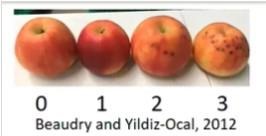By Anna Wallis
Todd Einhorn, associate professor in Michigan State University’s Department of Horticulture, recently shared his M.S. student, Chayce Griffith’s, work demonstrating that auxin and abscisic acid (ABA) applications can be used to mitigate bitter pit. This article summarizes the main findings of his presentation. You can also watch the recording of Einhorn’s presentation.

Honeycrisp with increasing levels of bitter pit. Photo by Beaudry and Yildiz-Ocal 2012.
Bitter pit is a calcium-related disorder that commonly occurs in Honeycrisp. Symptoms include sunken pits at the calyx end of the fruit caused by calcium deficiency and nutrient imbalance. Many factors can contribute to this nutrient imbalance and effective delivery of calcium within the fruit. First, calcium is only transported via xylem (not phloem). Xylem within the fruit is under significant strain, beginning as early as 30 days after full bloom. By the end of the season, there may be few remaining intact xylem connections. In addition, calcium competes with other nutrients, notably potassium (K), magnesium (Mg) and nitrogen (N).
Auxins, a group of plant hormones, play an important role in calcium transport in several ways. Indole acetic acid (IAA), the native auxin in plants, is well known to be involved in xylem differentiation as well as the flexibility of xylem tissue. Therefore, IAA promotes better vascular structures needed for effective Ca delivery. In addition, auxin mediates the transport of calcium.
Abscisic acid (ABA) is another plant hormone that plays a role in calcium delivery. ABA increases Ca delivery directly by increasing xylem function and by regulating Ca genes. It may also act indirectly. ABA reduces transpiration, leading to the direction of more water and calcium to the fruit (as opposed to leaves). Further, it indirectly inhibits shoot growth by closing stomata which reduces gas exchange. Both of which result in better Ca supply to fruit.
Based on this information, the Einhorn lab has been testing the hypothesis that applications of auxin and ABA will increase xylem differentiation and the functional life of vascular tissues in fruit, which will in turn improve fruit calcium concentration and ultimately reduce bitter pit.
In experiments using Honeycrisp on G.11 rootstock (bitter pit-susceptible trees), IAA, NAA or ABA was applied three times: 30, 45 and 60 days after full bloom (DAFB). Applications timings were no earlier than 30 DAFB so that there was no thinning effect, and no later than 60 DAFB because xylem differentiation is complete by this point. Fruit were sampled and dyed to visualize xylem bundles at 86, 107 and 136 DAFB (approximately three weeks after the last treatment, two weeks later and at harvest). Each material was tested at different rates.
As expected, overall vascular bundle functionality of non-treated Honeycrisp apples diminished both over time. In addition, vascular bundles were fewer closer to the calyx end of the fruit (see photo below).
 Staining of different types of vascular bundles in a Honeycrisp fruit at 86, 107 and 136 days after full bloom. Photo by Chayce Griffith.
Staining of different types of vascular bundles in a Honeycrisp fruit at 86, 107 and 136 days after full bloom. Photo by Chayce Griffith.All three materials had a positive effect on xylem functionality and bitter pit. IAA significantly increased vascular bundles at the earlier sampling times (86 and 107 DAFB) in a rate-dependent manner (5, 10 or 20 ppm). NAA applied at a rate of 5 or 10 ppm was effective at all sampling times, but 20 ppm was toxic to the fruit. ABA applied at a rate of 75 and 150 ppm was also effective at increasing the number of functional bundles at 107 and 136 DAFB.
Both IAA and ABA significantly reduced bitter pit by 65% in both harvest and post-harvest evaluations. NAA reduced bitter pit by about 50% at harvest and post-harvest, albeit not at the level of significance tested. These changes were accompanied by an increase in xylem-mobile nutrients (Ca and Fe) in peel tissue, as well as an improvement in K+Mg/Ca ratios.
Einhorn’s group is continuing work in 2022 evaluating IAA, ABA and NAA. In addition, they are investigating other forms of auxin that may be commercially available, such as IBA and the gibberellin inhibitor, PcA. We expect growers will be excited about this work and interested in trying this on their farms. However, research results are early, and we recommend waiting for an additional year of research to better inform commercial applications.
Source : msu.edu